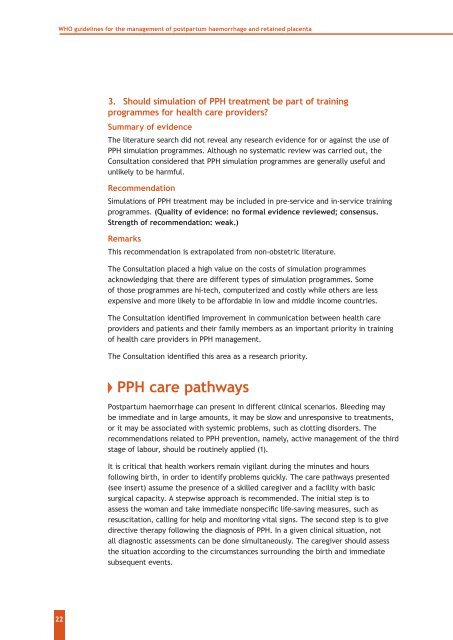WHO guidelines for the management of postpartum haemorrhage ...
WHO guidelines for the management of postpartum haemorrhage ...
WHO guidelines for the management of postpartum haemorrhage ...
You also want an ePaper? Increase the reach of your titles
YUMPU automatically turns print PDFs into web optimized ePapers that Google loves.
<strong>WHO</strong> <strong>guidelines</strong> <strong>for</strong> <strong>the</strong> <strong>management</strong> <strong>of</strong> <strong>postpartum</strong> <strong>haemorrhage</strong> and retained placenta<br />
3. Should simulation <strong>of</strong> PPH treatment be part <strong>of</strong> training<br />
programmes <strong>for</strong> health care providers?<br />
Summary <strong>of</strong> evidence<br />
The literature search did not reveal any research evidence <strong>for</strong> or against <strong>the</strong> use <strong>of</strong><br />
PPH simulation programmes. Although no systematic review was carried out, <strong>the</strong><br />
Consultation considered that PPH simulation programmes are generally useful and<br />
unlikely to be harmful.<br />
Recommendation<br />
Simulations <strong>of</strong> PPH treatment may be included in pre-service and in-service training<br />
programmes. (Quality <strong>of</strong> evidence: no <strong>for</strong>mal evidence reviewed; consensus.<br />
Strength <strong>of</strong> recommendation: weak.)<br />
Remarks<br />
This recommendation is extrapolated from non-obstetric literature.<br />
The Consultation placed a high value on <strong>the</strong> costs <strong>of</strong> simulation programmes<br />
acknowledging that <strong>the</strong>re are different types <strong>of</strong> simulation programmes. Some<br />
<strong>of</strong> those programmes are hi-tech, computerized and costly while o<strong>the</strong>rs are less<br />
expensive and more likely to be af<strong>for</strong>dable in low and middle income countries.<br />
The Consultation identified improvement in communication between health care<br />
providers and patients and <strong>the</strong>ir family members as an important priority in training<br />
<strong>of</strong> health care providers in PPH <strong>management</strong>.<br />
The Consultation identified this area as a research priority.<br />
PPH care pathways<br />
Postpartum <strong>haemorrhage</strong> can present in different clinical scenarios. Bleeding may<br />
be immediate and in large amounts, it may be slow and unresponsive to treatments,<br />
or it may be associated with systemic problems, such as clotting disorders. The<br />
recommendations related to PPH prevention, namely, active <strong>management</strong> <strong>of</strong> <strong>the</strong> third<br />
stage <strong>of</strong> labour, should be routinely applied (1).<br />
It is critical that health workers remain vigilant during <strong>the</strong> minutes and hours<br />
following birth, in order to identify problems quickly. The care pathways presented<br />
(see insert) assume <strong>the</strong> presence <strong>of</strong> a skilled caregiver and a facility with basic<br />
surgical capacity. A stepwise approach is recommended. The initial step is to<br />
assess <strong>the</strong> woman and take immediate nonspecific life-saving measures, such as<br />
resuscitation, calling <strong>for</strong> help and monitoring vital signs. The second step is to give<br />
directive <strong>the</strong>rapy following <strong>the</strong> diagnosis <strong>of</strong> PPH. In a given clinical situation, not<br />
all diagnostic assessments can be done simultaneously. The caregiver should assess<br />
<strong>the</strong> situation according to <strong>the</strong> circumstances surrounding <strong>the</strong> birth and immediate<br />
subsequent events.<br />
22
















